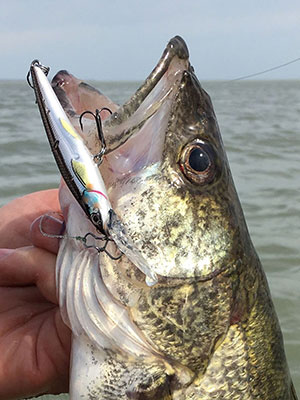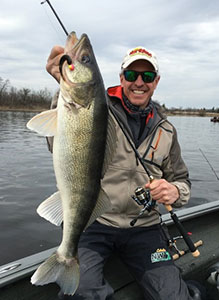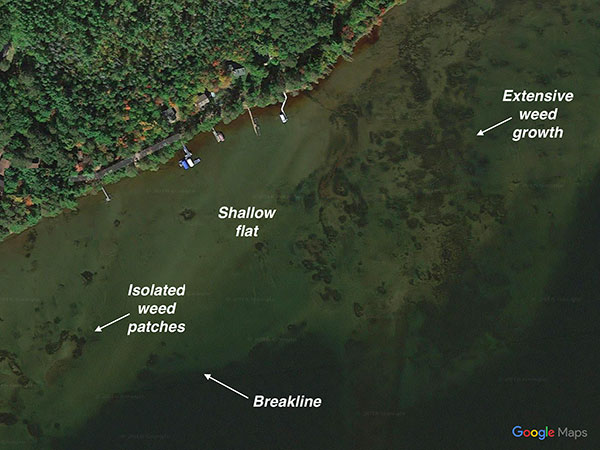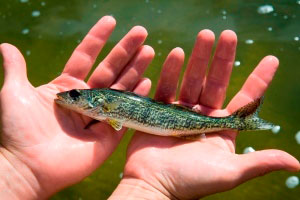- Details
By Chip Leer
 Don’t Get Stuck Without StickbaitsJigs are popular springtime walleye lures, but don’t overlook versatile, slim-profile stickbaits in your quest for early season success.
Don’t Get Stuck Without StickbaitsJigs are popular springtime walleye lures, but don’t overlook versatile, slim-profile stickbaits in your quest for early season success.
Also commonly called minnowbaits or jerkbaits, these baitfish-imitating hardbaits are deadly weapons when schools of spring-run walleyes flood into tributaries and bottlenecks between lakes.
So many fish gathered in a small area creates opportunities for fast action. Your odds of landing a lunker also improve astronomically compared to your chances when fish are scattered on the main lake.
You can tap the spring run from a boat or the bank. Afoot or afloat, I like casting to prime near-shore shallows. Top spots include 2- to 8-foot depths over a firm sand, gravel or rocky bottom.
- Details
By Chip Leer
Fishing the WildSide
 Chip Leer with River WalleyeSpringtime walleye spawning migrations offer anglers a chance to enjoy some of the year’s best fishing for ’eyes of all sizes, from tasty eaters to sag-bellied trophies. The trick to tapping this annual rite of spring is being in the right place at the right time, with the right presentation.
Chip Leer with River WalleyeSpringtime walleye spawning migrations offer anglers a chance to enjoy some of the year’s best fishing for ’eyes of all sizes, from tasty eaters to sag-bellied trophies. The trick to tapping this annual rite of spring is being in the right place at the right time, with the right presentation.
While you can catch spring-run walleyes in a variety of streams and rivers, some of the fastest action occurs in tributaries of large lakes. Classic examples include the Rainy River, which flows into Lake of the Woods, and the Saginaw River at Lake Huron’s Saginaw Bay, but you can find fish stacked up in inflows virtually across the Walleye Belt.
March and April are prime times in many fisheries. Online fishing reports and social media posts often track the action; local guides, bait shops and state fishery agencies are also great sources of information.
Hard-bottom flats above and below holes are great places to intercept migrating walleyes. Key depths vary with water conditions. Low and slow scenarios push fish deeper, while high, fast water sends walleyes toward the bank and even into backwaters.
 Northland Fishing Tackle’s hydrodynamic Current Cutter Jig
Northland Fishing Tackle’s hydrodynamic Current Cutter Jig
Bladebaits, lipless crankbaits, jerkbaits and 3-way rigs catch fish, but it’s hard to beat vertical jigging. Northland Fishing Tackle’s hydrodynamic Current Cutter Jig is my top choice because it slices through strong current and has a wire keeper for holding plastic trailers like Northland’s IMPULSE Core Swimbait or Ringworm in place. I generally add a piece of meat like a minnow above the plastic for extra bulk and taste.
Gear-wise, I favor a medium-action spinning rod like 13 Fishing’s 6’-9” Muse Gold, with 6- to 10-pound-test Bionic Walleye Braid mainline, tied direct to the jig in low-vis conditions common in many rivers.
Experiment with jig strokes to see what the walleyes want. Sometimes hovering in place is best; other times hopping or standard bottom-bouncing tactics put the most spring walleyes in the boat.
- Details
Dr. Jason Halfen
(Provided by Traditions Media)
 Preparing to pull walleyes through an eight-inch hole in the ice begins not on the water, but at your computer.
Preparing to pull walleyes through an eight-inch hole in the ice begins not on the water, but at your computer.
With the arrival of hardwater across the northland, the much-anticipated ice fishing season has begun. Intrepid anglers, with ice picks draped over their shoulders and lightweight gear in tow, are now creeping across the shallows of their favorite lakes in search of the season’s first frozen success stories.
Many early-season walleye hunters are immediately drawn to the weed-studded breaklines that rim deeper basins; textbook locations that will produce apex predators for much of the season. However, these anglers are also walking right over large numbers of relatively unpressured walleyes that continue to prowl shallow flats during the first few weeks of ice.
Want to learn how to find and catch those fish? Read on!
Preparing to pull walleyes through an eight-inch hole in the ice, with only a few feet of water beneath, begins not on the water, but at your computer. This is one of the times that I make extensive use of satellite imagery to visually inspect the shallow areas of clear lakes, looking specifically for flats or bays that have distinct patches of heavy weed growth. The larger these patches are, the more baitfish they will harbor, and the more walleyes they will attract.
Turning these satellite-located weedbeds into easy-to-find fishing spots is simple: on Google Maps, just drop a pin where you would like to drill a hole, and then save that location. Now, open up the Google Maps app on your phone or mobile device, and presto: the magic of 21st century technology has your future-8-inch-hole-location displayed in its correct position, making it easy to find when you hit the ice.
- Details
(Provided by MDNR)
 Volunteers Help Michigan Grow Bigger WalleyesFall is harvest time in Michigan, and while most may be thinking of picking apples or plucking pumpkins, Michigan DNR fisheries crews are thinking about walleye.
Volunteers Help Michigan Grow Bigger WalleyesFall is harvest time in Michigan, and while most may be thinking of picking apples or plucking pumpkins, Michigan DNR fisheries crews are thinking about walleye.
Specifically, they're collecting the last of the walleye fingerlings that are raised in rearing ponds for stocking and getting the fish to where they want them to be.
For the most part, walleye are reared for a short period of time in ponds and stocked as spring fingerlings - most at less than 2 inches in length - in high densities. But fisheries biologists know that fall fingerlings can be stocked at much lower densities and produce better results than spring fingerlings.
Recently, DNR technician supervisor Ed Pearce brought his crew (technicians Mike Wilson and Matt Smith) to the state's walleye ponds near Belmont in Kent County to get the walleye out of the ponds and into a couple of southern Michigan lakes.
A dozen or so members of the West Michigan Walleye Club, who spent the summer babysitting the ponds, assisted the crew in the operation.





